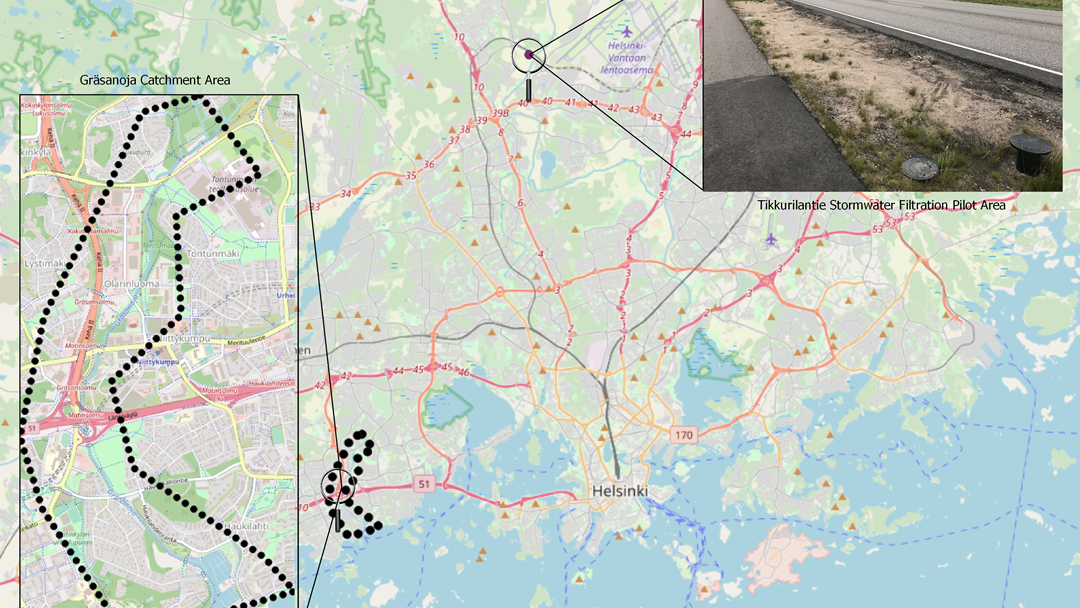Case Finland
Finnish case study: Tikkurilantie Stormwater Filtration & Gräsanoja Catchment
Summary
The Finnish case study incorporates two areas with implemented NBS; one stormwater filtration pilot study located in Vantaa Municipality and the other being Gräsanoja Urban catchment in Espoo Municipality.
The Stormwater Filtration pilot area is located in Vantaa Municipality Finland, approximately 17km from Helsinki City Centre. The case study area is located adjacent to Tikkurilantie roadway and consists of two 34m2 pilot stormwater filters: a sand filter and a combination sand and birch biochar filter, with each filter having a catchment area of approximately 100m2.
The Tikkurilantie case study will build upon earlier research from the pilot area, which assessed the stormwater filtration impacts on discharged water quality against 30 hydrological and physiochemical properties, with an emphasis placed on Metals, Suspended Solids and Nutrients removal via the two-stormwater filters.
The overall goal of the Stormwater filtration component is to determine the long-term and seasonal pollutant removal efficiency of the respective stormwater filters, and the standardisation and validation of pollutant removal mechanisms occurring within each of the stormwater filters.
The second case study location is the Gräsanoja catchment area, an urbanised catchment located in the Espoo Municipality of the Greater Helsinki Metropolitan Area. The total catchment area is approximately 24 km2 and neighboured on the west by the Finnoonoja and on the east by the Monikonpuro catchment areas.
Gräsanoja catchment is significant due to the fact that the catchment discharges to the sea, is subject to sea water intrusion due to climate change variables, has been heavily altered and urbanised and is the focus of Espoo municipality’s 2016-2022 Gräsanoja Flood Protection and Rehabilitation Plan (Espoo 2019).
In addition to the case studies, the municipalities of Espoo and Vantaa will form part of the EviBAN Integrated Sustainability Assessment (ISA) of Nature Based Solutions.

Challenges of Finnish Case Study
There are several challenges associated with both the Finnish case study areas, included but not limited to;
- Lack of long-term monitoring of field studies utilising roadside stormwater filtration. There is also an associated lack of knowledge in the long-term temporal-spatial behaviour of implemented NBS/NWRM, particularly stormwater filters, in cold climates.
- Absence of knowledge on the pollutant removal mechanisms, which has led to development of stormwater filter by trial and error, as opposed to systemic development of filtration systems.
- No defined Finnish requirements for discharging stormwater quality, leading to no legislative treatment performance indicators in Finland.
Objectives of Finnish Case Study
Apart from the EviBAN overall objectives, the main objectives of the respective Finnish case study areas are to:
- Develop and intensify the investigation of the Tikkurilantie stormwater filtration pilot, quantifying the temporal-spatial transport and subsequent removal processes and performance of filter materials.
- Parameterise geochemical and stormwater quality behaviour across temporal-spatial and climatic scenarios for the standardisation of LID/NBS parameters in a local context.
- Assessment of the implemented NBS/NWRM and their effect on the overall hydrological behaviour of stormwater within Gräsanoja catchment.
- Assessment, development, implementation and management of NBS/NWRM tools to improve urban water management practices in Vantaa and Espoo Municipality.
Research Methods
The Finnish case study incorporate the following research methods:
- Continuation and intensification of the stormwater filtration experiments to determine the removal performance of pollutants from case study biofilter materials.
- Quantifying temporal-spatial transport of stormwater pollutants, and subsequent removal processes.
- Determine parameterisation of geochemical and stormwater properties behaviour across various temporal, spatial and climatic scenarios, incorporating reactive hydrochemical transport for typical NWRM and similar systems, to assess climate factor sensitivity and determine model optimisation and scenarios to assist with the design and maintenance of NWRM and similar NBS in cold climate areas.
- Mapping of Municipality and relevant stakeholders ecological systems, current NWRM/NBS best practice and assessment of drivers and barriers for the implementation and
Ongoing Activities and Desired Results
Currently, there is ongoing measurements undertaken at the Tikkurilantie Stormwater Treatment site. During rain events, samples of the influent and effluent- from each respective filter- are analysed for general physiochemical parameters, metals and nutrients. There is also constant measurements of rainfall and discharge from the site – 5-minute intervals- which allows for the accurate determination of inflows and outflows from the system.
These results of the analysis from the Tikkurilantie site form the basis for the hydrogeochemical modelling analysis, which determines the pollutant removal efficiency, removal mechanisms and processes occurring with the filters.
Due to the ongoing and previous measurements from the Tikkurilantie site, there is a planned analysis of the system in relation to snowmelt, freezing and refreezing characteristics on site. This provides valuable information into how stormwater filtration systems behave over varying temporal and seasonality conditions in cold climate areas, which is lacking in much of literature and field studies.
For the Gräsanoja catchment, the assessment of the implemented NBS/NWRM and their effect on the overall hydrological behaviour of stormwater within Gräsanoja catchment is still ongoing. The parameters for the investigation may include flooding and environmental protection aspects.
There is continual discussion with both Espoo and Vantaa Municipalities (and relevant stakeholders) to effective map the respective ecosystem services for the ISA. There are tentative 2020 meetings with each municipality and stakeholders to assess, develop and implement the EviBAN NBS/NWRM tools to improve urban water management practices.